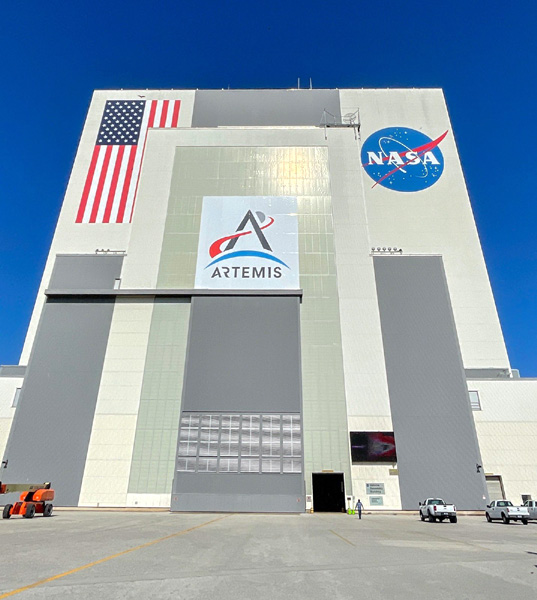
NASA
Kennedy at 60: Vehicle Assembly Building Ready for New Era of Launch Vehicles (News Release)
Standing 525 feet-tall and containing 130 million cubic feet of interior space, the iconic Vehicle Assembly Building (VAB) at Kennedy Space Center in Florida has been a shining beacon for NASA’s space program since the early 1960s. This is the facility where launch vehicles for the Apollo, Skylab and space shuttle programs were stacked and processed before their rollout to Launch Complex 39A or B for liftoff into space.
As the center celebrates its 60th anniversary this year, the VAB is the site where the next generation of launch vehicles will be stacked and processed for NASA’s Artemis missions to the Moon and beyond.
“We have witnessed the beginning of some of the most historical moments of the space program within the walls of the VAB. Saturn V, space shuttle, and now the Space Launch System – each launch vehicle started their journey in the VAB,” said Explorations Ground Systems (EGS) Program Manager, Mike Bolger. “The work that has taken place to get us to this moment with SLS fully stacked in High Bay 3 has been remarkable, and we cannot wait to see it roll out to Launch Pad 39B where it will serve as NASA’s next giant leap in deep space exploration with the launch of Artemis I.”
Currently, the agency’s massive Space Launch System (SLS) rocket and Orion spacecraft for Artemis I are undergoing integrated testing stacked atop the mobile launcher in High Bay 3 before being readied for a trial run to Pad B. The high bay was upgraded by EGS beginning in 2014. The project removed old platforms and installed 10 levels of new work platforms. A total of 20 platform halves surround the rocket and spacecraft to provide access for testing and processing before SLS and Orion roll out atop the crawler-transporter along the crawlerway to Pad B.
Initially conceived as the Vertical Assembly Building, it was renamed the Vehicle Assembly Building in 1965 during construction. The Max O. Urbahn architectural firm in New York City designed it. The VAB spans 8 acres and is one of the largest buildings in the world by volume. At a width of 518 feet, the building is made of 65,000 cubic yards of concrete and its frame contains 98,590 tons of steel. Completed in 1966, the building includes a low bay, four high bays, a transfer aisle, and several heavy-lift cranes.
To date, 12 Apollo missions, four Skylab missions, one Apollo-Soyuz Test Project, one Ares I mission, and all 135 space shuttle missions were processed through the VAB.
The VAB has received a number of distinctions. It was listed in the National Register of Historic Places on Jan. 21, 2000. In January 2020, the American Society of Civil Engineers designated the VAB as a National Historic Civil Engineering Landmark. The Florida Association of The American Institute of Architects honored the facility and its adjacent Launch Control Center with a “Test of Time” design award, recognizing the contributions of the architects and engineers of these unique buildings.
Contrary to popular stories circulated during construction, the VAB, which is mostly not air-conditioned, does not create its own weather – reports of indoor rain, clouds, or fog are myths.
Jose Perez Morales, the EGS senior project manager for the VAB and Pad 39B elements, has worked at Kennedy since 1985. “Because of the massive amount of steel and volume of the building, temperatures inside the VAB can fluctuate from very cold to very hot depending on the outside weather,” Perez Morales said. “To prevent the formation of a wind tunnel in the transfer aisle during high winds, the procedure is to close the north and south doors.”
The VAB sports a large American flag – a 209-foot-tall, 110-foot-wide stars and stripes painted on the exterior of its south side. Each star measures six feet across, and the blue field is the size of a basketball court. The flag originally was painted onto the VAB in 1976 for the Bicentennial Exposition on Space and Technology. A 12,300-square-foot NASA logo also adorns the south side of the facility.
Recently, the flag and NASA logo were repainted using more than 500 gallons of paint. A giant Artemis banner also was added above the low bay entrance, signifying NASA’s goal through Artemis missions to establish a sustainable human presence on and around the Moon to prepare for missions to Mars.
Source: NASA.Gov
****

NASA / Frank Michaux

No comments:
Post a Comment